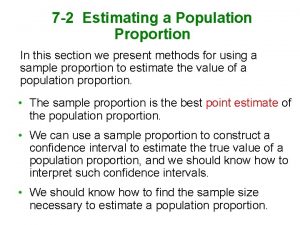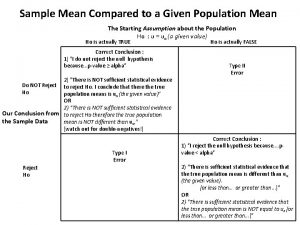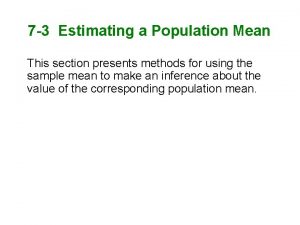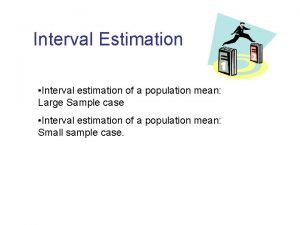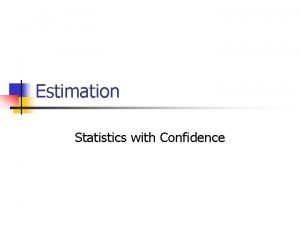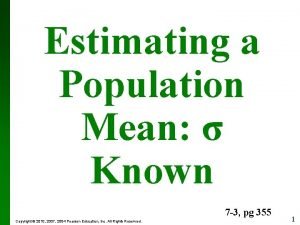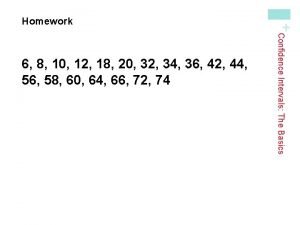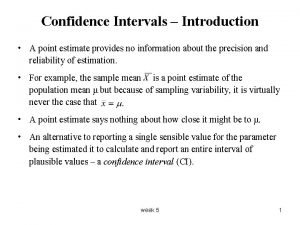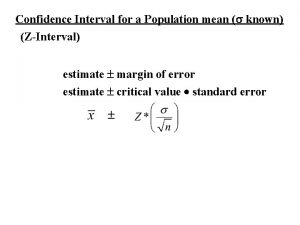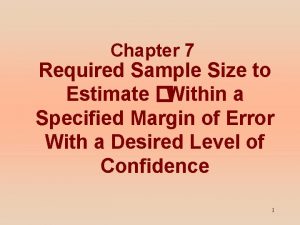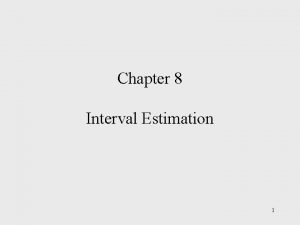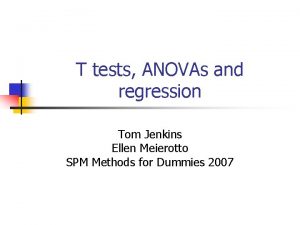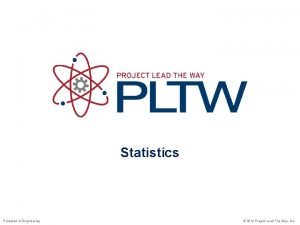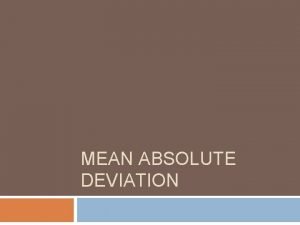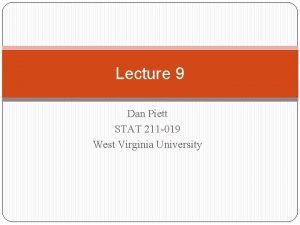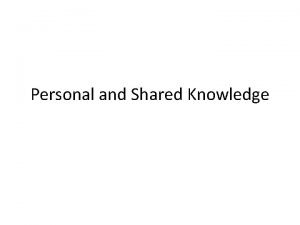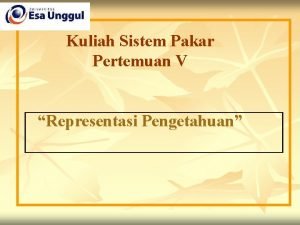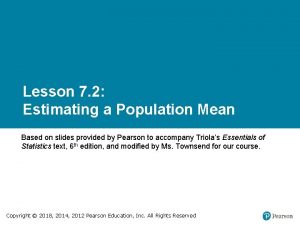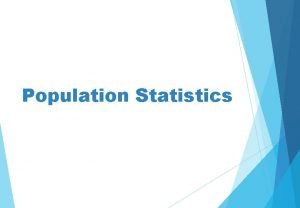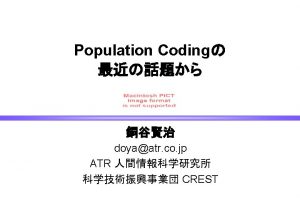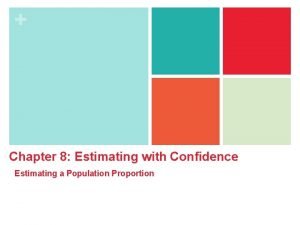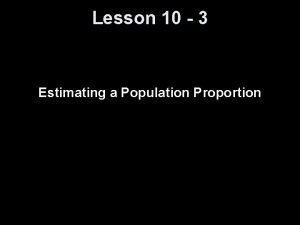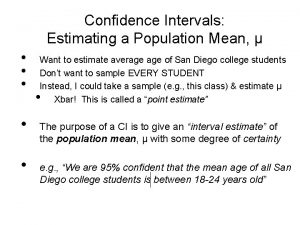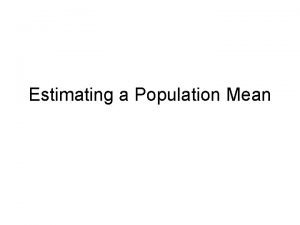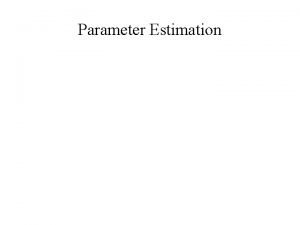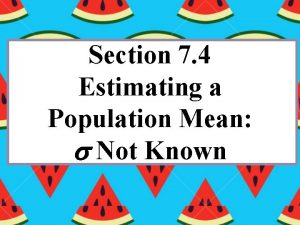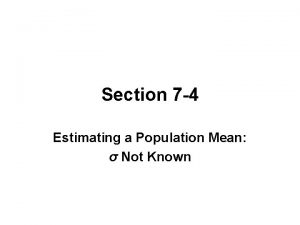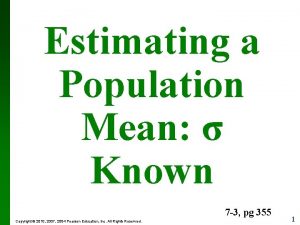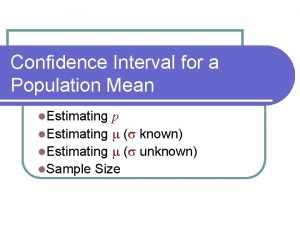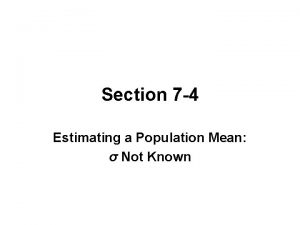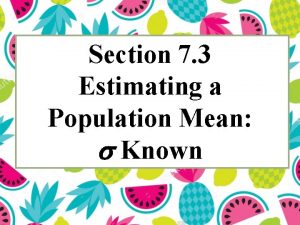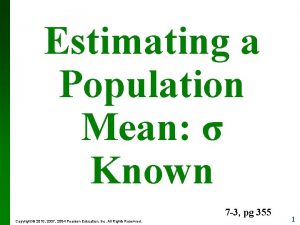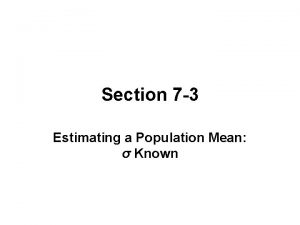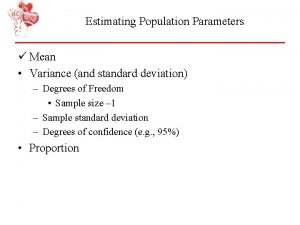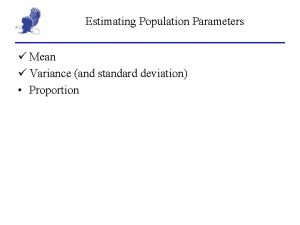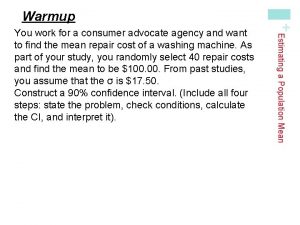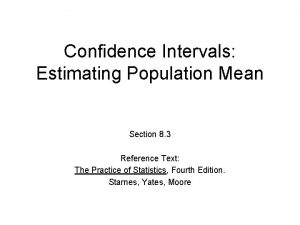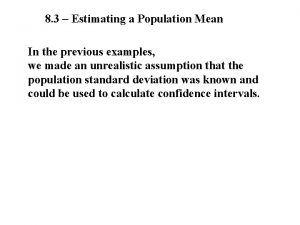Lesson 10 2 Estimating a Population Mean Knowledge




























- Slides: 28

Lesson 10 - 2 Estimating a Population Mean

Knowledge Objectives • Identify the three conditions that must be present before estimating a population mean. • Explain what is meant by the standard error of a statistic in general and by the standard error of the sample mean in particular. • List three important facts about the t distributions. Include comparisons to the standard Normal curve. • Describe what is meant by paired t procedures. • Explain what is meant by a robust inference procedure and comment on the robustness of t procedures. • Discuss how sample size affects the usefulness of t procedures.

Construction Objectives • Use Table C to determine critical t value for a given level C confidence interval for a mean and a specified number of degrees of freedom. • Construct a one-sample t confidence interval for a population mean (remembering to use the four-step procedure). • Calculate a level C t confidence interval for a set of paired data.

Vocabulary • Statistics

Conditions with σ Unknown • Note: the same as what we saw before

Standard Error of the Statistic • Note: the standard error of the sample mean is two parts of the MOE component to confidence intervals • The z-critical value will be replaced with a t-critical value.

Properties of the t-Distribution • The t-distribution is different for different degrees of freedom • The t-distribution is centered at 0 and is symmetric about 0 • The area under the curve is 1. The area under the curve to the right of 0 equals the area under the curve to the left of 0, which is ½. • As t increases without bound (gets larger and larger), the graph approaches, but never reaches zero (like an asymptote). As t decreases without bound (gets larger and larger in the negative direction) the graph approaches, but never reaches, zero. • The area in the tails of the t-distribution is a little greater than the area in the tails of the standard normal distribution, because we are using s as an estimate of σ, thereby introducing further variability. • As the sample size n increases the density of the curve of t get closer to the standard normal density curve. This result occurs because as the sample size n increases, the values of s get closer to σ, by the Law of Large numbers.

T-Distribution & Degrees of Freedom • Note: as the degrees of freedom increases (n -1 gets larger), the t-distribution approaches the standard normal distribution

T-critical Values ● Critical values for various degrees of freedom for the t-distribution are (compared to the normal) n Degrees of Freedom t 0. 025 6 5 2. 571 16 15 2. 131 31 30 2. 042 101 100 1. 984 1001 1000 1. 962 Normal “Infinite” 1. 960 ● When does the t-distribution and normal differ by a lot? ● In either of two situations § The sample size n is small (particularly if n ≤ 10 ), or § The confidence level needs to be high (particularly if α ≤ 0. 005)

Confidence Interval about μ, σ Unknown Suppose a simple random sample of size n is taken from a population with an unknown mean μ and unknown standard deviation σ. A C confidence interval for μ is given by PE MOE LB = x – t* s --n s UB = x + t* --n where t* is computed with n – 1 degrees of freedom Note: The interval is exact when population is normal and is approximately correct for nonnormal populations, provided n is large enough (t is robust)

T-Critical Values t-distribution curve -t* t* • We find t* the same way we found z* • t* = t( [1+C]/2, n-1) where n-1 is the Degrees of Freedom (df), based on sample size, n • When the actual df does not appear in Table C, use the greatest df available that is less than your desired df

Effects of Outliers are always a concern, but they are even more of a concern for confidence intervals using the t-distribution – Sample mean is not resistant; hence the sample mean is larger or smaller (drawn toward the outlier) (small numbers of n in t-distribution!) – Sample standard deviation is not resistant; hence the sample standard deviation is larger – Confidence intervals are much wider with an outlier included – Options: • Make sure data is not a typo (data entry error) • Increase sample size beyond 30 observations • Use nonparametric procedures (discussed in Chapter 15)

Example 1 We need to estimate the average weight of a particular type of very rare fish. We are only able to borrow 7 specimens of this fish and their average weight was 1. 38 kg and they had a standard deviation of 0. 29 kg. What is a 95% confidence interval for the true mean weight? Parameter: μ PE ± MOE Conditions: 1) SRS 2) Normality 3) Independence shaky assumed shaky Calculations: X-bar ± tα/2, n-1 s / √n 1. 38 ± (2. 4469) (0. 29) / √ 7 LB = 1. 1118 < μ < 1. 6482 = UB Interpretation: We are 95% confident that the true average wt of the fish (μ) lies between 1. 11 & 1. 65 kg for this type of fish

Example 2 We need to estimate the average weight of stray cats coming in for treatment to order medicine. We only have 12 cats currently and their average weight was 9. 3 lbs and they had a standard deviation of 1. 1 lbs. What is a 95% confidence interval for the true mean weight? Parameter: μ PE ± MOE Conditions: 1) SRS 2) Normality 3) Independence shaky assumed > 240 strays Calculations: X-bar ± tα/2, n-1 s / √n 9. 3 ± (2. 2001) (1. 1) / √ 12 LB = 8. 6014 < μ < 9. 9986 = UB Interpretation: We are 95% confident that the true average wt of the cats (μ) lies between 8. 6 & 10 lbs at our clinic

Match Pair Analysis The parameter, μ, in a paired t procedure is the mean differences in the responses to the • two treatments within matched pairs • two treatments when the same subject receives both treatments • before and after measurements with a treatment applied to the same individuals

Example 3 11 people addicted to caffeine went through a study measuring their depression levels using the Beck Depression Inventory. Higher scores show more symptoms of depression. During the study each person was given either a caffeine pill or a placebo. The order that they received them was randomized. Construct a 90% confidence interval for the mean change in depression score. Subject 1 2 3 4 5 6 7 8 9 10 11 P-BDI 16 23 5 7 14 24 6 3 15 12 0 C-BDI 5 5 4 3 8 5 0 0 2 11 18 1 4 6 19 6 3 13 1 -1 Diff Enter the differences into List 1 in your calculator

Example 3 cont Parameter: μdiff PE ± MOE Conditions: 1) SRS 2) Normality Not see output below 3) Independence > DOE helps Output from Fathom: similar to our output from the TI

Example 3 cont Calculations: x-bardiff = 7. 364 and sdiff = 6. 918 X-bar ± tα/2, n-1 s / √n 7. 364 ± (1. 812) (6. 918) / √ 11 7. 364 ± 3. 780 LB = 3. 584 < μdiff < 11. 144 = UB Interpretation: We are 90% confident that the true mean difference in depression score for the population lies between 3. 6 & 11. 1 points (on BDI). That is, we estimate that caffeine-dependent individuals would score, on average, between 3. 6 and 11. 1 points higher on the BDI when they are given a placebo instead of caffeine. Lack of SRS prevents generalization any further.

Random Reminders • Random selection of individuals for a statistical study allows us to generalize the results of the study to the population of interest • Random assignment of treatments to subjects in an experiment lets us investigate whethere is evidence of a treatment effect (caused by observed differences) • Inference procedures for two samples assume that the samples are selected independently of each other. This assumption does not hold when the same subjects are measured twice. The proper analysis depends on the design used to produce the data.

Inference Robustness • Both t and z procedures for confidence intervals are robust for minor departures from Normality • Since both x-bar and s are affected by outliers, the t procedures are not robust against outliers

Z versus t in Reality • When σ is unknown we use t-procedures no matter the sample size (always hit on AP exam somewhere)

Can t-Procedures be Used? No: this is an entire population, not a sample

Can t-Procedures be Used? Yes: there are 70 observations with a symmetric distribution

Can t-Procedures be Used? Yes: if the sample size is large enough to overcome the right-skewness

TI Calculator Help on t-Interval • Press STATS, choose TESTS, and then scroll down to Tinterval • Select Data, if you have raw data (in a list) Enter the list the raw data is in Leave Freq: 1 alone or select stats, if you have summary stats Enter x-bar, s, and n • Enter your confidence level • Choose calculate

TI Calculator Help on Paired t-Interval • Press STATS, choose TESTS, and then scroll down to 2 -Samp. TInt • Select Data, if you have raw data (in 2 lists) Enter the lists the raw data is in Leave Freq: 1 alone or select stats, if you have summary stats Enter x-bar, s, and n for each sample • Enter your confidence level • Choose calculate

TI Calculator Help on T-Critical • On the TI-84 a new function exists inv. T • We will have to get an APP transferred from Mrs Barrett that will allow us to do the same thing • Press APPS and choose inv. T • Enter (1+C)/2 (in decimal form) • This will give you the t-critical (t*) value you need

Summary and Homework • Summary – In practice we do not know σ and therefore use tprocedures to estimate confidence intervals – t-distribution approaches Standard Normal distribution as the sample size gets very large – Use difference data to analyze paired data using same t-procedures – t-procedures are relatively robust, unless the data shows outliers or strong skewness • Homework – Day One: pg 648 – 650; 10. 27 -10. 31 – Day Two: pg 657 – 661; 10. 34, 35, 37, 38, 41
 Estimating population proportion
Estimating population proportion Sample mean vs population mean
Sample mean vs population mean Sample mean vs population mean
Sample mean vs population mean Chapter 4 population ecology test answer key
Chapter 4 population ecology test answer key Population ecology section 1 population dynamics answer key
Population ecology section 1 population dynamics answer key Population ecology section 1 population dynamics
Population ecology section 1 population dynamics Study guide section 1 population dynamics
Study guide section 1 population dynamics Point estimate
Point estimate How to get population mean
How to get population mean The population mean μ is called: *
The population mean μ is called: * Degrees of freedom for 95 confidence interval
Degrees of freedom for 95 confidence interval Confidence interval for population mean
Confidence interval for population mean Confidence interval for population mean
Confidence interval for population mean Population mean example
Population mean example Example of population mean
Example of population mean Population mean
Population mean Standard deviation formula
Standard deviation formula How to calculate the mean absolute deviation in excel
How to calculate the mean absolute deviation in excel Wvu stat 211
Wvu stat 211 Personal vs shared knowledge
Personal vs shared knowledge Knowledge shared is knowledge squared meaning
Knowledge shared is knowledge squared meaning Knowledge shared is knowledge multiplied meaning
Knowledge shared is knowledge multiplied meaning Knowledge creation and knowledge architecture
Knowledge creation and knowledge architecture Contoh shallow knowledge dan deep knowledge
Contoh shallow knowledge dan deep knowledge Synthetic a posteriori
Synthetic a posteriori Book smart vs street smart
Book smart vs street smart Knowledge and knower
Knowledge and knower Gertler econ
Gertler econ Prefix for knowledge
Prefix for knowledge
